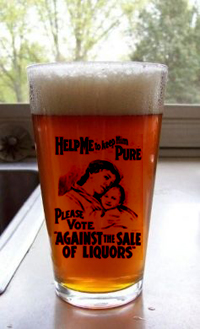|

Dutch Courage: A History
of Booze in America
(continued)
By Joan Schonbeck
Even before either Carry Nation or Henry Ford, other
Americans had been reaching the same conclusions. As early as 1846,
the year Carry was born, Maine had become the first state to vote in
prohibition, though it later repealed it. By 1869, the Prohibition Party
had become a viable American political entity. Particularly in World
War I's decade, 1910-1920, prohibition and women's rights seemed to
run in tandem, gaining strength, as one state after another gave women
the vote and banned booze. From the scientific community came yet another
blow. Alcohol, always classified as a stimulant and regularly prescribed
by physicians, was discovered to actually be a depressant. In 1914,
American psychiatrists and neurologists took it one step further when
they declared alcohol a poison.
"Goodbye, John (Barleycorn)... you were God's worst
enemy... Hell's best friend!" jubilant preacher Billy Sunday thundered
from a stage in Detroit on January 16, 1920. The National Prohibition
Act, better known as the Volstead Act, was passed by a zealous Congress,
vetoed by seriously ill Woodrow Wilson, and enacted when Congress overrode
that veto. (This may be the most powerful argument against the rumors
that Edith Wilson ran the country in those years). As noted, it was
far from the first time that booze had been banned in America. For three-quarters
of a century, individual states had voted in, and then repealed, prohibition.
Native Americans might have predicted its future. From nearly day one
of their association with whites, they had been denied the right to
legally drink. For them, three hundred years of prohibition had produced
a people with an alcoholism rate disproportionately higher than that
of their non-Native American neighbors. But no matter. In 1920, most
thought prohibition was here to stay.
By 1922, the Detroit River, a natural divider between
the United States and Canada, literally had a "navy" of federal,
state and local lawmen operating on its waters, trying to stanch the
flow of booze out of Canada. "Importing" liquor was a definite
growth industry. In Canada, during U.S. prohibition, distilleries accounted
for one-fifth of the country's GNP! Rum running began as a Mom-and-Pop
enterprise, with entire families smuggling whiskey out of Canada. They
brought it across the Detroit River in everything from rowboats, high-powered
launches and tugboats to cables across the river's bottom. In winter,
cars chanced the frozen river, often with fatal results. The police
chases, when the ice didn't crack, were worthy of a Laurel and Hardy
movie. Overland trips featured high-speed cars capable of (shades of
James Bond) emitting smoke screens and even deadly mustard gas as rum
running became more "professional."
Bootlegging had become the second biggest industry in
Detroit! Ecorse, Michigan, directly across the river from the Canadian
distilleries, transformed itself from a sleepy little town into Michigan's
Barbary Coast, a mecca for silk-shirted hoods and assorted characters
dedicated to quenching America's thirst: for a healthy profit. One Ecorse
woman earned $30,000 transporting booze in 1924. (Contrast this with
the lawmen enforcing prohibition, whose annual salary was below $2,000).
Big money gave birth to gangs with colorful names like
the East Side, Oakland Sugar House, and Purple Gangs, the Jewish Navy
and Peajacket's Navy. Most of them were garden-variety criminals, but
Peajacket's Navy was an exception. "Peajacket" was actually
John Wozniak, an entrepreneur in his early twenties. He and twenty-five
"sailors" worked out of Ecorse throughout the Twenties. They
carried no guns, and succeeded mostly through bribery or outwitting
the law. Wozniak's love of sports proved his undoing. Peajacket's Navy
put together their own football team, which gained a certain amount
of fame in the area. Unfortunately, police took to attending all of
their games to familiarize themselves with the gang members. Wozniak
was arrested in 1928, and shortly sold off his fleet of boats and turned
honest. In later years he ran an automobile dealership, and continued
to have his football team.
Many weren't as peaceful as Peajacket's Navy. Bodies washed
up on the shores of the Detroit every morning, victims of rival gangs
or the law. Frustrated law officers (those who weren't "on the
take") often reacted with indiscriminate savagery to the bootleggers.
A Twenties bumper-sticker read, "Don't shoot! I'm not a bootlegger."
Famed social worker Jane Addams noted, "What prohibition needs
first of all is disarmament!" Before Prohibition was repealed in
1932, 144 civilians and 60 lawmen had lost their lives in the "Battle
of the Booze."
Family-run stills had once again become a profitable cottage
industry, producing hooch with names like "Detroit White Lightning."
The quality of the liquor sold varied from rotgut that could kill to
high-quality liquor sold by a man named Willie McCoy, who gave us the
expression, "The real McCoy." "Old Log Cabin" was
another much-sought-after Canadian whiskey that Detroit's Purple Gang
smuggled in for Al Capone. It was the hijacking of a shipment of this
"Old Log Cabin" by the Bugs Moran Gang that brought about
Chicago's St. Valentine's massacre in 1929.
America's great social experiment, begun with such high
hopes, deteriorated into a nightmare of violence and crime. Bootleggers
introduced their product to college students and grade-school children,
in shocking similarity to drug dealers today. There were other similarities.
Family life deteriorated, with child abuse and desertion increasing,
as Prohibition continued. One-third of all federal prison cells held
Prohibition-related offenders. The train to the Detroit House of Correction
was nicknamed "the Moonshine Special." In spite of Elliot
Ness and others like him, Roy Vanderbrook, Michigan State Police commandant,
faced reality: "As long as people maintain their present attitude
toward Prohibition, the law is unenforceable."
Henry Ford, who had touted the '20s boom years as proof
that it did work, lost his best argument with the stock market crash.
By the time FDR drove the final nail in its coffin, most Americans had
no doubt that Canadian distilleries and bootleggers had gained the most
from Prohibition.
 
|